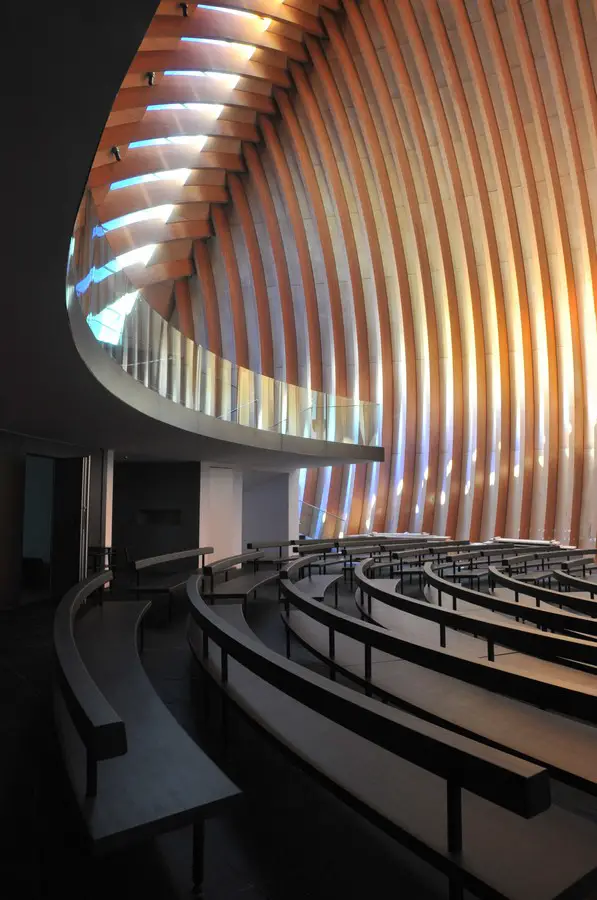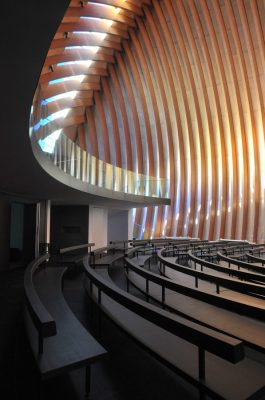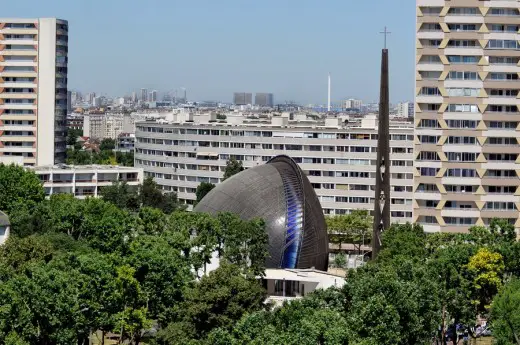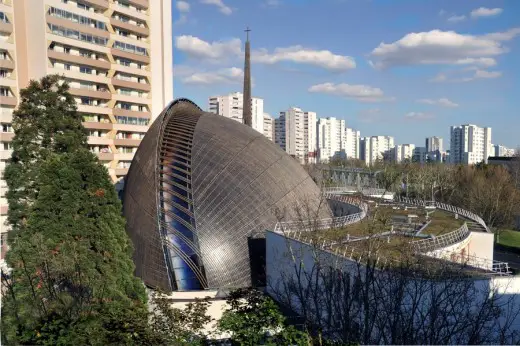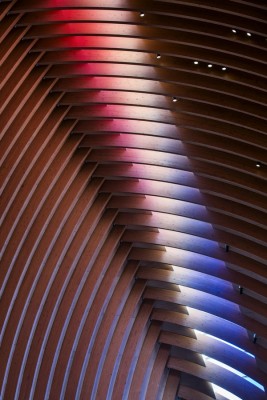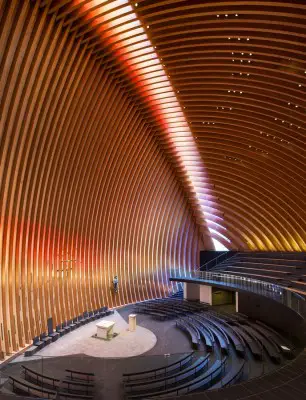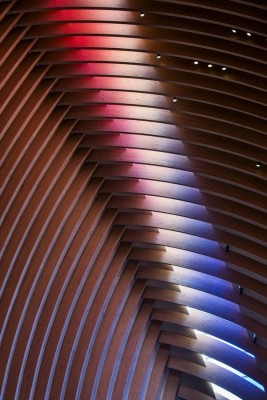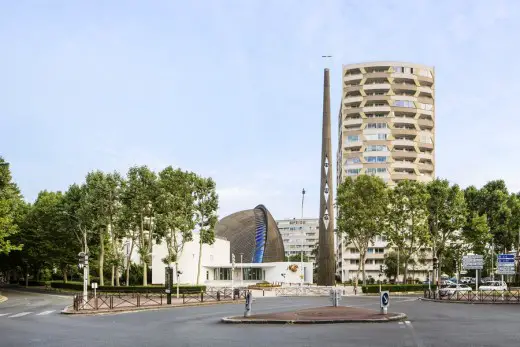Cathedral of Creteil, Paris Church Building, Design, Interior, Images
Cathedral of Creteil
Place of Worship in France – design by Architecture-Studio
18 Sep 2015
Cathedral of Creteil in Paris
Design: Architecture-Studio
Location: Creteil, Paris, France
The expansion of the Cathedral of Créteil
In 2009, on the initiative of Bishop Santier, the diocesan association of Créteil, supported by the Chantiers du Cardinal, opted for an ambitious project to expand the Cathédrale Notre-Dame de Créteil. Conceived by Charles-Gustave Stoskopf, holder of the Prix de Rome, this architecture is typical of the 1970s when “the theology of blending-in” prevailed at the time. It is part of the contemporary heritage of the City of Créteil.
The commission was to double the capacity of the cathedral and to enhance its visibility towards the city.
More than a renovation, this project involved a major redevelopment of the cathedral, giving it a new architectural lease on life from a symbolic and pastoral point of view. The new cathedral is anchored in a multicultural city, which includes five Catholic churches, ten synagogues, a mosque, a Protestant church, four Evangelical churches, a Buddhist temple and a Bahai assembly.
A dialogue between two different architectural styles, yet consistent, is established. The dome pointing skywards is based on the footprint of the original cathedral. The silhouette of the entrance, on a human scale, is now joined with the monumental proportions of the new project, focusing on the nave of the cathedral that extends from two spherical wood-clad hulls, like two hands joined in prayer that meet above the altar.
Large gatherings can be held in this new space. The existing sanctuary has been remodeled and the benches are placed in a broad semicircle. In daylight, the stained-glass window located at the junction of the two hulls shed a colored light onto the sanctuary, while at night, illuminated from inside, they become the symbol of a living Christian community.
The steeple, detached from the building on the corner of the forecourt, marks the cathedral entrance with its slender silhouette, punctuated by three bells from the old campanile. It restores the building urban scale and become a sign in the city beside the large residential buildings of the neighborhood. The view onto the cathedral forecourt is freed by opening the curtain of trees. The new square, built by the city on the opposite side, is an amenity for local residents, and an extension of parish life.
Having thus determined the architectural element of the project, we still had to determine the specifics. The new spatial organisation of the cathedral provided us with the framework we needed.
The two cylindrical concrete walls that support a horizontal terrace situated about 5 metres high from the ground, become two tridimensional wooden hulls that converge at 20 metres above the altar.
The liturgical axis was born from the creation of a chapel facing the sanctuary, in place of the former garden. It is marked by the presence of the baptistry. We decided that this axis, which would be the route of solemn processions in the cathedral, would become the standard for arranging all the structures: thus the supporting arches of the shells are all drawn in parallel to this liturgical axis.
This unique and particular architectural expansion is defined by the liturgical axis. The geometric complexity of the design – each arch is unique, mirrored on either side of the axis – creates a space under tension, at once static and dynamic. Each mouvement becomes a particular experience, especially through the “accelerations” of transparencies and opacities created by the progress of the arches on the spherical curve of the hulls.
This architecture in motion is illustrated by the steady arch of the hanged platform at the centre of the cathedral, thus creating a long travelling.
The warmth of wood
The white architecture of Stoskopf serves as the setting for the new cathedral, clad all in wood, inside and out.
This unity of material refers back to the ancient cathedrals, where the mass of these stone vessels was cut and chiseled by the light. This allows a straightforward reading of the two layers of the building, but most importantly, stands for unity and simplicity. The repetition of spruce arches gives rhythm to the interior decorative style of the hulls. The intention here is not to offer an optimal structure, calculated to the finest degree, nor to display any technical prowess, but to characterise the density of a sacramental space. There are as many arches as intertwinning possibilities at the top of the dome.
The boat of Peter, fisher of souls, is also suggested here.
Outside, the cladding of the hull and the steeple are also handled in wood, following the same parallel geometry of the arches. The wooden strips of Douglas fir are pre-shaded to ensure an aesthetically uniform ageing.
Wood is a natural, living material, at once humble and noble. It lends itself perfectly to the design of the building’s curves. Its warmth also serves as a pattern of a fraternal community, united in the celebration of the sacraments of the Church.
And by the light
Another mouvement, another axis, perpendicular to the previous one, crosses the space of the cathedral. This axis is the one of the stained glass, whose colored light encircles the space from its zenith. There is also an ascending path that rises to the source of this light: a mouvement from the altar to the two access steps to the gallery, which is extended by the curve of the stained glass. A path of light hangs vertically from the altar, climax of the composition of the Udo Zembok’s magnificent stained glass. The cross thus signs this space in three Dimensions, a space that vibrates to the rhythm of day and seasons, the orientation of the cathedral on the points of the compass — give or take a few degrees — and the positioning of the stained glass at the head of the southern hull, allowing the building to receive sunlight throughout the day.
A sense of community
The semicircular shape, as well as the use or non-use of the galleries, gives a feeling of fullness to the community regardless the number of faithful present at the celebrations. The tiered spaces of the conference room and the auditorium continue this modularity, with their movable partitions opening out into the cathedral. The extended cathedral can accomidate up to 1000 people.
The Masses in the chapel conveys both a sense of intimacy and belonging to the cathedral, through the view of the sanctuary and the cathedra.
The organ area, located at the top of the galleries, can also accommodate a choir for major celebrations.
The two narthexes
Access to the expanded cathedral is still effected by the two entrances of the original construction, refurbished and christened “small” and “large narthex” for the occasion. The large narthex has been stripped of the fire escape, which occupied part of its façade, to open fully onto the forecourt. In keeping with the original intention of Charles Gustave Stoskopf, access to the cathedral from the public space is thus made even more fluid.
Inside the two narthexes, a glass wall affords a view of the southern hull plunging to the ground to form two entry portals bathed in light. The threshold between sacred space and profane space is clearly marked.
The double door leading to the entrance, located under the terraces of the galleries, is deliberately dark, with low ceilings, which makes the entrance even more spectacular.
The cultural centre
The extension of the cathedral included the creation of a cultural centre intended to offer cultural and artistic events to the Val-de-Marne’s inhabitants.
A conference room and a small auditorium occupy the space originally dedicated to two multipurpose rooms. These spaces are accessible through an exhibition gallery that connects the two entrance narthexes. At its centre, a skylight allows a glimpse of the cross on the steeple. The sunlight goes trough a skylight and illuminates the entrance to each room. Near the large narthex, a bookstore café creates a friendly space at the entrance of the cathedral.
Cathedral of Creteil – Building Information
Contracting authority: Diocesan Association of Créteil and Association “Chemin des arts” in Val-de-Marne
Delegated contracting authority: Les Chantiers du Cardinal
Assisting contracting authority: TEWAKO
Project management:
Architect: Architecture-Studio
Structure and wrap: T/E/S/S
Fluids: Louis Choulet
Acoustics: AVA
Light designer: 8’18”
Economy: Éco-Cités
Wood specialist: Sylva Conseil
Total cost: 9 million euros before tax
Cost of work: 5,75 million euros before tax
Competition: 2009
Completion: 2015
© synthesized images: Architecture-Studio / T/E/S/S
© photographs: Luc Boegly / Yves Mernier / Udo Zembok
Stained glass
Stained-glass window conception: Pascale and Udo Zembok
Stained-glass window art direction: Udo Zembok
BET glass: Hoffmann GTD
Window’s production: Glasmalerei Peters Studio
Corportations
First group: LEON GROSSE Any building trades off budget
Second group: Envelopes
Mandatary: FARGEOT LAMELLE COLLE (ARBONIS)
Wood, opaque envelope carpenters and cover, on-roof
wood and internal dressings of shells
Subcontractors: CABROL
Glazed banner, steel structure of forums, bell tower and
roofs terraces
Dimensions
Surface of the deployment: 1 400 sqm
Height of the cathedral: 22,40 m
Height of the bell tower-signal: 44,50 m
Beam south shell in the axis: 19,57 m for 63 bows
Beam north shell in the axis: 19,95 m for 64 bows
Section of stuck-laminated bows: 160 x 750 mm
Axis between the bows: 560 mm
Surface of the shells: 1 600 sqm
Laminated wood stuck bows in spruce: 350 m3
Metallic frame: 40 tons
Wooden strips of douglas: linear 25 000 metres
Cathedral of Creteil in Paris images / information from Architecture-Studio
Architecture-Studio
Location: Creteil, Paris, France
New Paris Architecture
Contemporary Paris Architecture
Paris Building Designs – chronological list
Paris Architecture Tours by e-architect
Projet Triangle
Herzog & de Meuron
Projet Triangle
Tour Eiffel, Rue de Champ de Mars, VIIe
Gustave Eiffel
Eiffel Tower : most famous structure in Paris, heroic iron architecture
Comments / photos for the Cathedral of Creteil in Paris page welcome
Website: Cathédrale of Creteil

